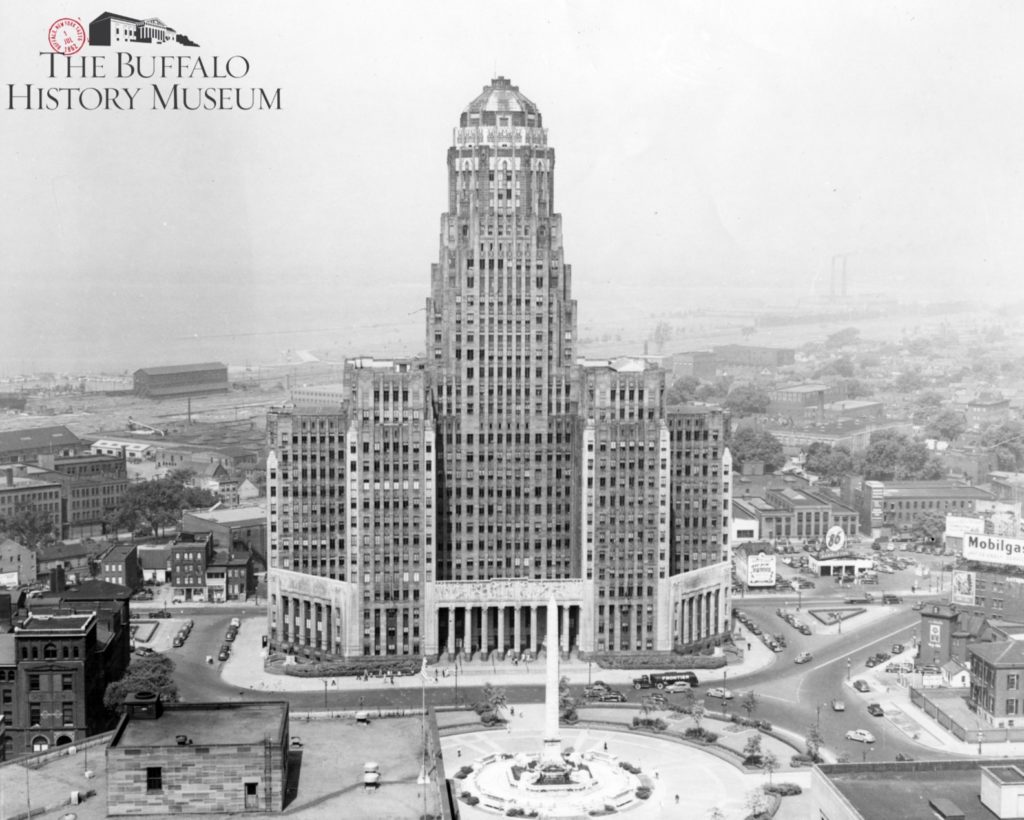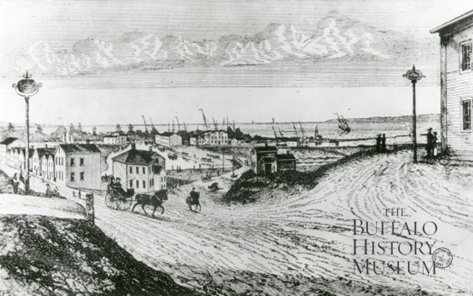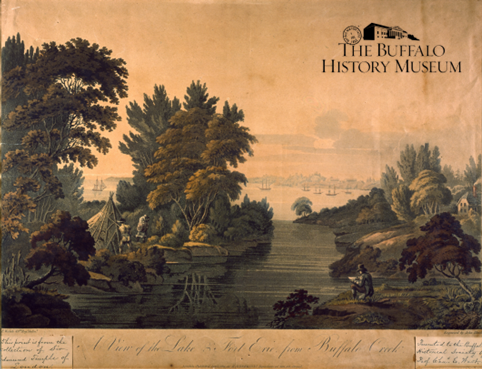How Did Buffalo Get Its Name?
June 22, 2022 • By Cynthia Van Ness
If you have spent much time in Buffalo, you may have wondered how our fair city got its name. This is a question that authors, researchers, prominent citizens, and ordinary people have been trying to answer for almost as long as Buffalo has been a point on a map. Reasonable people have adopted and defended various theories as their favorites, picking their team and rooting for it ever after.

Aerial Photo of City Hall, 1941, taken from our collection.
So many theories have been proposed over the years that we had to sort them out on a spreadsheet to analyze who proposed what and when. All the theories agree that Buffalo, the city, took its name from Buffalo Creek, now called the Buffalo River. The name of Buffalo Creek first appeared on a map drawn ca. 1762 by Lt. George Demler, who was stationed at Fort Niagara at the time. The debate then revolves around how Buffalo Creek got its name. While we do not have enough space here to delve into an analysis of each theory, we’ll summarize each one, with its history, background, and an assigned “plausibility level” we reached based on our research and the evidence we found.
In chronological order, here are the seven dominant theories of the origin of Buffalo’s name.
1. The first theory to appear in print is Stolen Horsemeat (1825). Sheldon Ball recounted it in his self-published pamphlet, Buffalo in 1825. French explorers or missionaries in need of provisions found a horse presumably belonging to Native Americans, stole it, and served it to their party claiming it was bison meat. The place was remembered thereafter as Buffalo Creek. Ball himself admitted that he had no proof of it. Plausibility level: Low
2. The next theory to appear in print is Mistranslation of Beaver Creek (1862). Millard Fillmore championed this theory in 1862 during his inaugural speech as the first president of the newly-formed Buffalo Historical Society. There was a miscommunication between the Iroquois and American negotiators during the writing of the Treaty of Fort Stanwix in 1784. The Treaty’s use of “Buffaloe Creek” was a mistranslation of Beaver Creek. Plausibility Level: Low
3. The Buffalo Name Theory industry had a good year in 1863, perhaps inspired by a disagreement with Fillmore’s speech. Three new theories appeared in print courtesy of William Ketchum. The Seneca Named Buffalo theory (1863) is one of them. An old man whose Seneca name meant “Buffalo” lived by the creek. White settlers found him there, learned his name and its meaning, and so named the creek. Plausibility level: High

View of the Buffalo Harbor from The Terrace, 1825
4. The Bison Grazed Here theory (1863) is also courtesy of William Ketchum, who cites numerous sources from the 1700s that indicate the occasional presence of bison on the south shore of Lake Erie. Plausibility Level: Medium
5. The Mistranslation of Basswood theory (1863) holds that the Seneca called the area To-se-o-way or De-dyo-syo-oh, meaning “Place of the Basswood.” At the Treaty of Fort Stanwix in Rome in 1784, the Mohawk interpreter rendered it as Tick-e-ack-gou, meaning Buffalo. The Senecas and settlers thereafter used the name Buffalo. Plausibility Level: High

View of the Lake and Fort Erie from Buffalo Creek, 1811. We believe that this is the first image ever made of what is now Buffalo.
6. The Corruption of Beau Fleuve theory (1895) first appeared in print on March 23, 1895 in an unsigned review in the Buffalo Evening News of a talk on Buffalo’s inception given by Rev. Samuel T. Clarke. He proposed that unnamed French explorers bestowed the beau fleuve name, which was mangled by subsequent English settlers. No copies of Rev. Clarke’s speech are known to survive, so we do not have the theory in his own words and we do not know if he offered any evidence. Plausibility Level: Low
7. The Corruption of Boiblanc theory (1907). The name R. au boiblanc (French for “River of Basswoods”) appears on a map of what is now Upstate and Western New York. It was drawn in 1758 by Captain Pierre Pouchot, a military engineer, for the French army. William Beauchamp suggests that this phrase could have been corrupted as Buffalo. Plausibility Level: Low
So which theory is the correct and true origin of Buffalo’s name? Learn more at this page https://tinyurl.com/TBHM-BuffaloName citing all of our sources with more detail. We present arguments and evidence in favor and against the different theories. You can read most of the theories online and compare variations and iterations that accumulated over time. Did we miss a theory? Did we miss a good article in favor of or opposed to a particular theory? Let us know at library@buffalohistory.org!
Cynthia Van Ness is The Buffalo History Museum’s Director of Library & Archives.